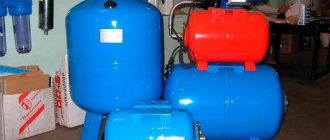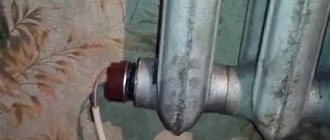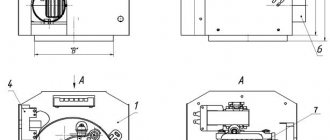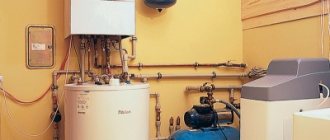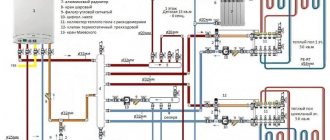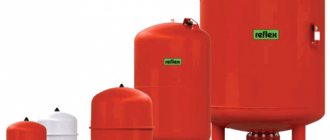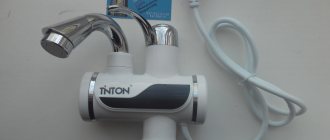In water supply systems, a hydraulic accumulator is used to accumulate, that is, accumulate liquid, and also to reduce excess pressure. In addition, the hydraulic accumulator maintains water pressure even when the pump is off, thereby reducing its wear.
The hydraulic accumulator serves to suppress water hammer and stabilize peak water flows. A synonym for the word hydraulic accumulator is the phrase “ expansion tank ”. Traditionally, hydraulic accumulators for heating systems are made in red, and for water supply systems - in blue.
Accumulator diagram
Hydraulic accumulator design
A container for accumulating water, inside of which there is a membrane or a bulb. Outside the tank there are pipes and valves for water in and out. There is air on the outside of the membrane, and water enters it from below. The shape of the membrane is identical to the shape of the tank.
At the bottom where the water enters there is a filter, and at the top there is a spool. Hydraulic accumulators with a bulb, for the most part, have a similar design, with the exception of horizontal options, when water is supplied from the side of the tank.
There is no big difference between a hydraulic accumulator with a bulb or with a membrane; what is important is the quality of the material from which they are made, for example, rubber, which is based on natural rubber.
Relay settings
To understand the principle of operation of the pressure switch on a hydraulic accumulator, you do not need to have special knowledge - everything is quite simple. Until it is completely filled, water is supplied to the tank with a membrane (or bulb) under pressure, which causes an increase in pressure in the system. When it reaches the maximum, the relay is activated and the water supply stops. As it is used, the pressure begins to drop, and when the minimum threshold is reached, the relay is activated again and the water supply is activated. The above cycle is repeated until the system is in good condition.
Selecting a hydraulic accumulator
The easiest way is to buy a hydraulic accumulator with a capacity of 24 liters and not bother. Just install it closer to the pump. If you have a fairly large house for a large family, you should make several calculations.
For example, if the productivity of your pump is about 40 liters per minute, the volume of the hydraulic accumulator should be about 100 liters, so as not to turn on the pump in vain. The optimal number for turning on the pump will be about 20-30 times per hour.
As for reserving water, the decision remains entirely yours; you must estimate for yourself how much you will need in case of a power outage.
When choosing a battery, you should also not forget about such a thing as pressure, which should not be lower than the pressure level in the heating system of your private home, that is, 1.5 bar. It consists of the pressure of the pipes and the tap.
The pressure in the battery should be checked at least twice a year.
Hydraulic accumulator installed in the system
Design features of the hydraulic accumulator
A hydraulic accumulator is a metal container divided into two conventional parts by a membrane: a diaphragm or a cylinder.
Hydraulic tanks with a diaphragm membrane consist of:
- water chambers;
- a diaphragm membrane that is installed across the tank; gas chamber;
- sockets with valve;
- connection pipe to the system.
Hydraulic tanks with a balloon-type membrane consist of:
- water chambers;
- a membrane cylinder, which is fixed at the inlet near the inlet pipe;
- sockets with valve; gas chamber;
- connection pipe to the system.
Hydraulic tanks are designed for:
- cold water supply;
- hot water supply;
- heating systems.
There are horizontal and vertical hydraulic accumulators.
More often, vertical hydraulic tanks are used for country houses. They have legs, as well as a special mount on the body for hanging on the wall. They take up little space.
Horizontal hydraulic tanks are most often used in pumping stations with external pumps. In this case, the pump is installed on the tank, which saves a lot of space.
A hydraulic accumulator with a membrane has a longer service life than a galvanized steel hydraulic tank
Is a hydraulic accumulator necessary for a submersible pump?
- The hydraulic accumulator is designed to protect the pump, because it stores a small amount of water that will be used when the tap is open.
- When installing a hydraulic accumulator, the following devices are additionally installed: pressure gauge, air vent and pressure switch.
- The hydraulic accumulator is installed in the house, in a special room or in a pit protected from precipitation.
If the accumulator is not installed, the pump will turn on constantly as soon as the tap is opened. In this regard, the likelihood of water hammer increases. Water hammer is formed by an abrupt increase in pressure, which appears due to frequent inclusions.
Therefore, the importance of the hydraulic accumulator is obvious. The hydraulic accumulator has several names; it is called a hydraulic tank, expansion tank or membrane tank.
Thus, the hydraulic accumulator performs the following functions:
- smoothing – helps to avoid water hammer;
- supporting - together with the relay, stable water pressure is maintained;
- protective – protects the pump from constant switching on, as well as in the absence of electrical energy, due to small reserves of water.
One half of the hydraulic tank contains compressed air under a pressure of 1.5 atm. The second part of the accumulator is filled with water. The volume of pressure is unchanged and does not affect the size of the container in any way.
The simplest device that helps measure pressure is a pressure gauge. The pressure gauge is connected to the hydraulic accumulator using a fitting.
If the check reveals that the pressure in the hydraulic tank has dropped, it can be easily increased to the required level using a bicycle pump through the nipple, which is located at the top of the equipment. And in order to reduce the pressure, it is necessary to bend the nipple valve and release the air.
When carrying out these actions, it is necessary to monitor the parameters on the pressure gauge.
Normal pressure in the accumulator is from 1.4 to 2.8 atm. The pressure in the system must exceed the pressure of the tank by 0.1 atm. If you need to calculate on your own what pressure in the accumulator needs to be adjusted, then use the following formula:
Hydraulic tank pressure = (Maximum disassembly point height +6) / 10
Connection diagram for hydraulic accumulator
The water supply system includes: a pump, a hydraulic accumulator, a pressure switch, a check valve, steam valves, a filter system, a pressure gauge, a pipeline, and, of course, electrical power.
The hydraulic accumulator is installed next to the external pump in a pit or indoors in the house, depending on where the space is allocated.
All devices that are necessary to connect all equipment are connected using a 5-pin connector.
The 5-pin fitting has outputs of different diameters, which is ideal when connecting a circuit for piping a hydraulic accumulator. Therefore, this element is the basis in the piping scheme of both a submersible and surface pump with a hydraulic accumulator.
First, the fitting is attached to the hydraulic tank, then a pressure gauge and pressure switch are connected to it. The last connections to the five-pin fitting are the pump pipe and the wiring to the house's water supply.
The check valve allows water to accumulate in the hydraulic tank from the submersible pump.
Installed on the pump before connecting the entire accumulator circuit in the following sequence:
- We lower the pump into the well;
- It is necessary to secure the safety rope that holds the pump;
- We connect all the elements of the circuit using a five-pin fitting;
- It is necessary to configure the pressure switch.
Pressure switch
The pressure switch plays an important role in the operation of the accumulator, as well as the entire home system. For efficiency and correct operation of the relay, it is necessary to configure it.
To do this you need:
- The first thing you need to do is get rid of the water in the water supply system; to do this, you need to open the tap, which is located below;
- The relay cover opens and the pump turns on to fill the system with water.
- After turning off the pump, it is necessary to remember the readings of the pressure gauge, which shows the pressure in the system;
- Again a small amount of water is released to start the pump. The pressure gauge readings are also recorded. Next, a mathematical calculation is made: subtract the smallest from the largest number. Further actions take place based on the number received. If the value is less than 1.4 bar, then the small spring nut on the relay must be tightened. If the value is greater than 1.4 bar, then loosen.
- The nut on the large spring in the relay can be used to regulate the water pressure. The actions are absolutely similar. More pressure tightens, less pressure weakens.
- All adjustments must be made with the pumping equipment turned off.
- After all the stages have been completed, you need to start the system and check how it works. You can adjust it an infinite number of times until everything is fine.
Installation of a hydraulic accumulator
Installation must be carried out exactly according to the instructions, or even better - with the help of specialists. If you still decide to do it yourself, here are some tips:
- Do not install batteries with visible external damage under any circumstances!
- In the place where you are going to install the battery, all operating conditions must comply with the manufacturer's instructions.
- Be sure to take into account the weight of the accumulator without water and with water!
- Take care in advance about where you will drain the water from the tank.
- There must be constant heating in the room so that the water in the accumulator does not freeze!
- No static loads on the hydraulic accumulator and water supply system.
- There must be external protection from the hydraulic accumulator from mechanical damage and moisture.
- Depending on the size of the battery, you should estimate how it will fit through the door of your home.
Now let's look at the main problems that you may have when using hydraulic accumulators and how to deal with them.
For example, if the pump turns on too often, this may indicate several factors:
- If there is not enough compressed air in the container, take a pump from a car and pump up the air.
- If the membrane is damaged, replace it yourself or with the help of specialists. If you chose the first option, be sure to read about it first. Change the membrane only to the original model. A broken membrane is usually immediately visible when water leaks from the air valve.
- If the tank's body is damaged, then everything is clear. You should call a professional and have it repaired.
- Use a pressure switch to adjust it if the difference between the pump on and off pressures is insignificant.
- If the air pressure is lower than the value that you calculated, then you should blow it out; the pressure will restore itself from the inside.
The next important problem may be a drop in water pressure, that is, a lack of pressure. This can happen mainly in two cases:
- There is no compressed air in the tank. You already know what to do in this case, pump it in there with a car pump.
- The pump cannot produce the required pressure. In this case, its technical characteristics are not designed for this, or it is simply faulty. We look for the malfunction and eliminate it, independently or with the help of specialists.
Photo of the hydraulic accumulator
Is it easy to install a hydraulic accumulator?
Summer residents immediately panic when they hear that the hydraulic accumulator must be connected to the water supply system. They think that the pipes may suddenly burst and then the entire dacha plot along with the house will be filled with water. This is wrong.
The hydraulic accumulator is installed according to a standard and proven scheme. Many summer residents have integrated their tanks using it. And they coped with the task perfectly. To do this, they purchased all the necessary components in the form of nipples, pumps and fittings.
To place it in the right place, you need to determine the water flow rate for the entire house. Determine the pump power and the volume of the accumulator. It is also worth knowing the location of the main water supply nodes.
Then look at the installation diagram and just do everything as indicated there.
At first glance, it seems that installing a tank is a difficult task. This is wrong. Decide on a location, look at the diagrams that the water supply system has. Buy the components for the connection and simply connect the tank to the general water supply system.
Bottom line
Water from a well or well enters the pump, and then goes into the hydraulic accumulator, or rather into its membrane. When a certain volume is filled, the pressure stops pumping water.
Further, when water begins to be consumed by the washing machine or shower, the sensors again give a signal to the pump, and water is pumped again. So we can draw the following conclusion:
- The hydraulic accumulator ensures the safety of the water supply and pump, and also allows you to save on electricity. At the same time, it is low cost and easy to maintain; all calculations regarding it can be made quite easily.
Connecting the accumulator to the system
In the standard version, the water supply system of a country house includes, in addition to the pipeline, components such as a pressure switch and a check valve that prevents the flow of water into the well. It must contain a pressure gauge, a pump and a hydraulic accumulator.
Connection to the system.
Features of connecting all of these elements come down to the choice of connection - with a fitting or in a more complex way.
With or without five-pin fitting
When a surface pump is connected, the hydraulic accumulator must be installed near it, while the check valve is placed on the suction pipes, and the remaining listed components are mounted in 1 bundle.
The connection is made using a five-pin fitting. It is a device with leads of different diameters corresponding to the elements listed above.
But the process can be carried out without a fitting, and fittings and pipe sections will be used instead. But this option is considered more labor-intensive and less reliable.
With a 1-inch diameter outlet, the fitting is installed on the tank so that the pipe faces downward, and pressure control devices are connected to the 1/4-inch outlets each. Then the remaining elements are added.
How to install two hydraulic tanks on one pump
Sometimes, during the use of the structure, water consumption increases and the equipped hydraulic tank is not enough. In such cases, you can install 1 more tank in parallel.
No system reconfiguration is required. The pressure switch must monitor the indicators in the accumulator in which it was originally supplied. But the reliability of the system increases - if 1 tank fails, the 2nd one will continue to work.
When an additional connection is made to a hydraulic accumulator, you need to install a tee at the input of the existing one, connect a pump to any of its outputs, and connect a new tank to the second one.
Connection diagram of the hydraulic accumulator to the pump and water supply system
Do-it-yourself installation of a hydraulic accumulator for individual water supply systems is done together with automation and adapters, which include a five-input switching fitting, a pressure gauge for adjustment and control, and a switching hydraulic relay. When using a deep-well electric pump in a water intake, the well piping includes a dry-running relay and a check valve, if it is not included in the pumping unit.
If a surface centrifugal electric pump is used in the water main, then it is more practical and cheaper to purchase a ready-made, assembled pumping station than to install the system elements yourself.
Rice. 4 Expansion tank in the station
How to connect a hydraulic accumulator for water supply systems (video)
A hydraulic accumulator for a water supply system is necessary if you want to have constant access to water in your home. It will regulate the pressure in the water supply network and give you the opportunity to enjoy clean water from the tap. The small container is easy to install, and it has many benefits for a private home. Buy a hydraulic accumulator and you will always have a constant supply of water in your home.
- Author: admin
Rate this article:
- 5
- 4
- 3
- 2
- 1
(0 votes, average: 0 out of 5)
Share with your friends!

